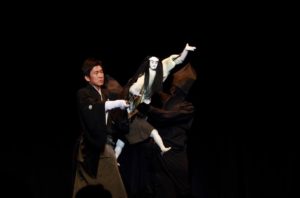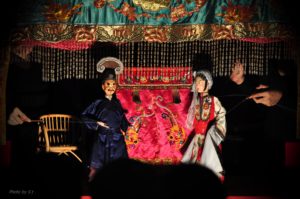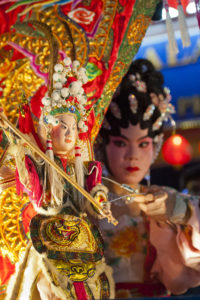 In collaboration with Johor Bahru: International Festival City, The Japan Foundation, Kuala Lumpur will bring six young leaders of the Japanese Bunraku scene who will astound audiences in Johor this 14 August with an elaborate showcase of poignant storytelling, live music and large puppets.
In collaboration with Johor Bahru: International Festival City, The Japan Foundation, Kuala Lumpur will bring six young leaders of the Japanese Bunraku scene who will astound audiences in Johor this 14 August with an elaborate showcase of poignant storytelling, live music and large puppets.
Designated by the Japanese government as an Intangible Cultural Property and by UNESCO as a World Intangible Cultural Heritage, Bunraku involves a number of puppeteers (ningyotsukai)?dressed in black against a dark backdrop as if invisible?who manipulate lavishly costumed large puppets. A single chanter (tayu) is responsible for expressing the dialogue and expressions of all characters in a script; while a shamisen player enhances the atmosphere of the play through his three-stringed lute.
The visit marks the fourth time the group has stepped foot into Malaysia to display the spellbinding appeal of the 300-year-old dramatic art. Members were part of a pioneering entourage that presented South East Asia?s first full-scale bunraku performance in Kuala Lumpur three years ago. In 2014, these masters-in-training returned to the capital for a joint demonstration with a wayang kulit troupe led by Kamrulbahri Hussin. They then debuted bunraku in Penang at the inaugural Butterworth Fringe Festival in 2015, which saw them share the stage with local practitioners of Potehi glove puppetry.
 Now in Johor, they are set to exhibit the techniques that have been handed down over three centuries. The programme opens with an excerpt from ?The Red-Hot Love of a Greengrocer?s Daughter?, one of 160 plays written during the Edo period (1603-1868) that remain in the national archive.
Now in Johor, they are set to exhibit the techniques that have been handed down over three centuries. The programme opens with an excerpt from ?The Red-Hot Love of a Greengrocer?s Daughter?, one of 160 plays written during the Edo period (1603-1868) that remain in the national archive.
The Kim Giak Low Choon Teochew Puppet Troupe will next take the spotlight with their rendition of ?The Love of the Celestial Fox?, chronicling the romance between the titular deity and a mortal after she descends to the human realm. Headed by fifth-generation Chinese opera thespian Ling Goh, the organisation is one of the last of its kind in the country, having persevered since the 19th century.
Date: 14 August, 2016 (Sunday) Time: 1.30 p.m. Admission: RM50 (front), RM10 (side). Tickets are sold at the door. Venue: Black Box, Mall of Medini, Iskandar Puteri, 79250 Johor
What is Bunraku?
Ranking with Noh and Kabuki as one of Japan?s foremost stage arts, the Ningyo Joruri Bunraku puppet theatre is a blend of sung narrative, instrumental accompaniment and puppet drama. This theatrical form emerged during the early Edo period when puppetry was coupled with Joruri, a popular fifteenth-century narrative genre. The plots related in this new form of puppet theatre are derived from two principal sources: historical plays set in feudal times (Jidaimono) and contemporary dramas exploring the conflict between affairs of the heart and social obligation (Sewamono). Approximately 160 works out of the 700 plays written during the Edo period have remained in today?s repertory. Nowadays, it attracts numerous young performers, and the aesthetic qualities and dramatic content of the plays continue to appeal to modern audiences.
Synopsis of the Fire Watchtower scene from ?The Red-Hot Love of the Greengrocer?s Daughter? (伊達娘恋緋鹿子/Date musume koi no higanoko)
Oshichi, a greengrocer’s daughter, is upset after she finds a sword lost by her lover Kichisaburo. The price for having made such a mistake is none other than seppuku. Oshichi wishes to inform him immediately but is unable to exit the city centre as all gates are closed and will only be reopened come daybreak. However, fire alarms are an exception to this rule. A desperate Oshichi spots a watchtower in the distance and proceeds to ring the bell, knowing all too well that sounding a false alarm is a serious crime.
Ningyojoruri Bunrakuza

What is Teochew puppetry?
The history of Teochew iron-rod puppetry began in the Central Plains  of China as shadow puppets. These shadow puppets were two-dimensional, made of dried leather strips and controlled with three long iron-rods attached to the arms and the torso. During the Southern Song period (11271279 CE), refugees fleeing south away from the instability and barbarian invasions of the time brought the art to the Chaozhou (or Teochew) region. There, it adopted many aspects of the rich local operatic tradition.
of China as shadow puppets. These shadow puppets were two-dimensional, made of dried leather strips and controlled with three long iron-rods attached to the arms and the torso. During the Southern Song period (11271279 CE), refugees fleeing south away from the instability and barbarian invasions of the time brought the art to the Chaozhou (or Teochew) region. There, it adopted many aspects of the rich local operatic tradition.
From the Qing dynasty onwards (c. 17th-century), in order to improve its visual impact, these shadow puppeteers experimented with removing the white screen (usually paper) between the audience and the puppets, so that the puppets became directly visible. To take full advantage of the greater dynamism this allows, the puppets became three-dimensional, first with hay, then more robust wooden bodies. These puppets have, however, retained the method of control of their shadow puppet antecedents that are their most unique feature, hence their classification as ?iron-rod? puppets.
Kim Giak Low Choon Teochew Puppet Troupe
In the 19th century, Ling Goh’s great-grandfather (first generation) brought his Lao Sai Yong Feng Opera Troupe from Chaozhou (Teochew) to Singapore, thereby becoming the first opera troupe to arrive in Southeast Asia. Lao Sai Yong Feng travelled and performed across Malaysia, Singapore, Thailand and Indonesia before finally settling in Penang. The troupe then renamed itself as Lao Rong Xiu Chun Puppet Troupe and mainly performed with puppets. It was later renamed to its current moniker of Kim Giak Low Choon Teochew Puppet Troupe.
The Kim Giak Low Choon Teochew Puppet Troupe has persevered till today, now helmed by fifth-generation head Ling Goh, who is also the curator of the Penang Teochew Puppet and Opera House. In 2008, the group was a recipient of the Penang Intangible Cultural Heritage Award.



